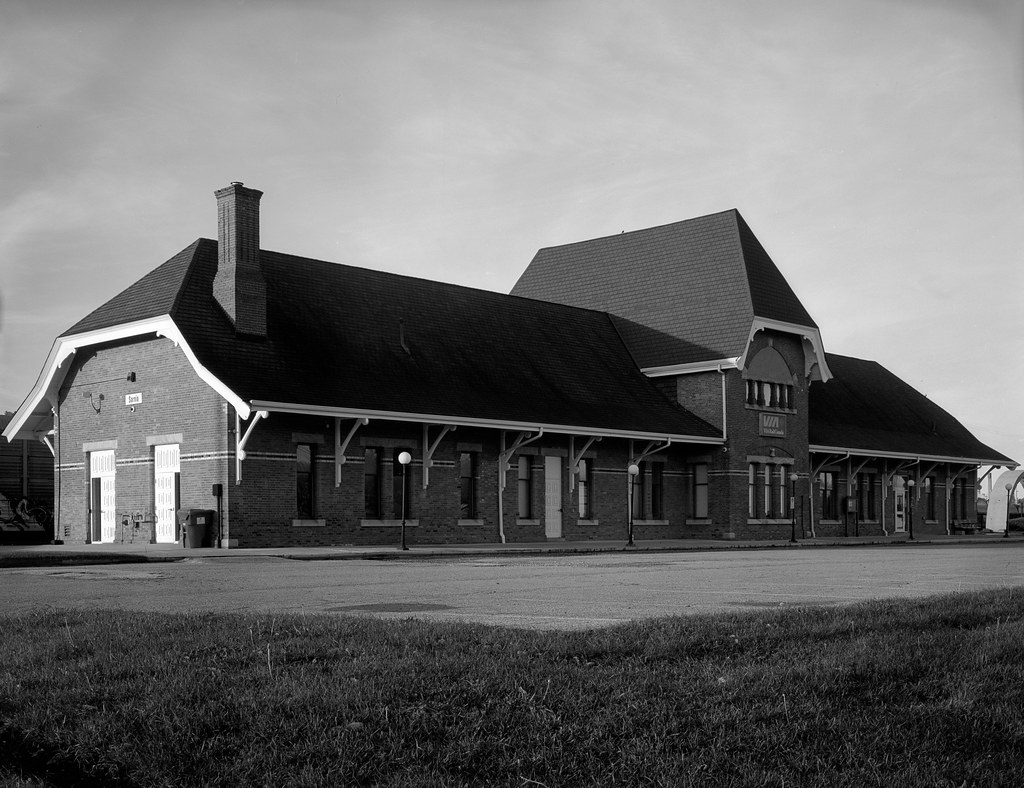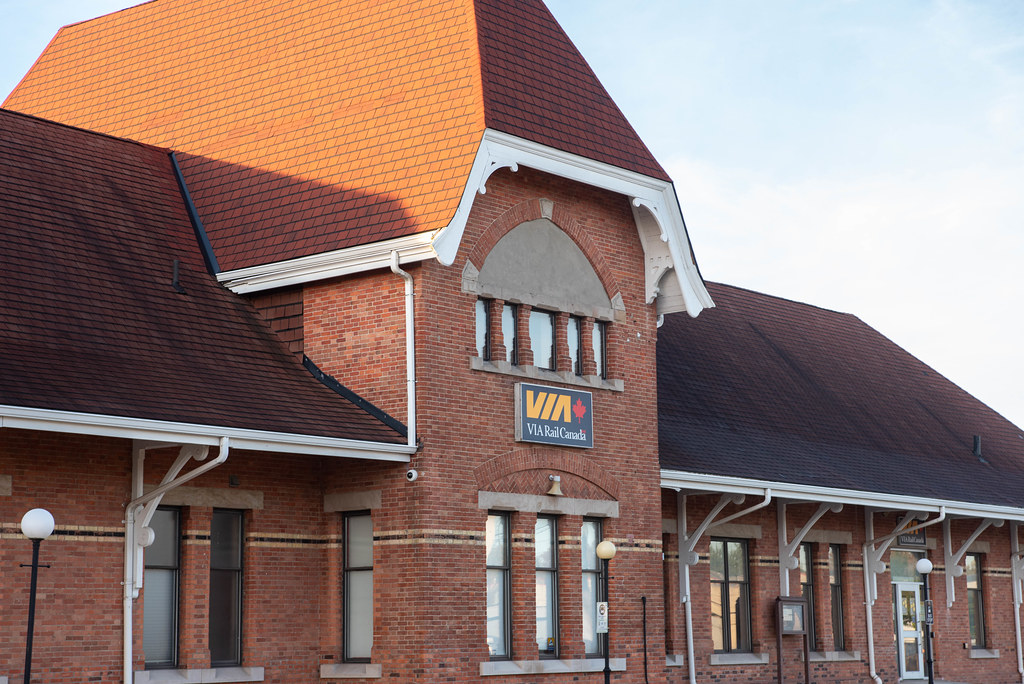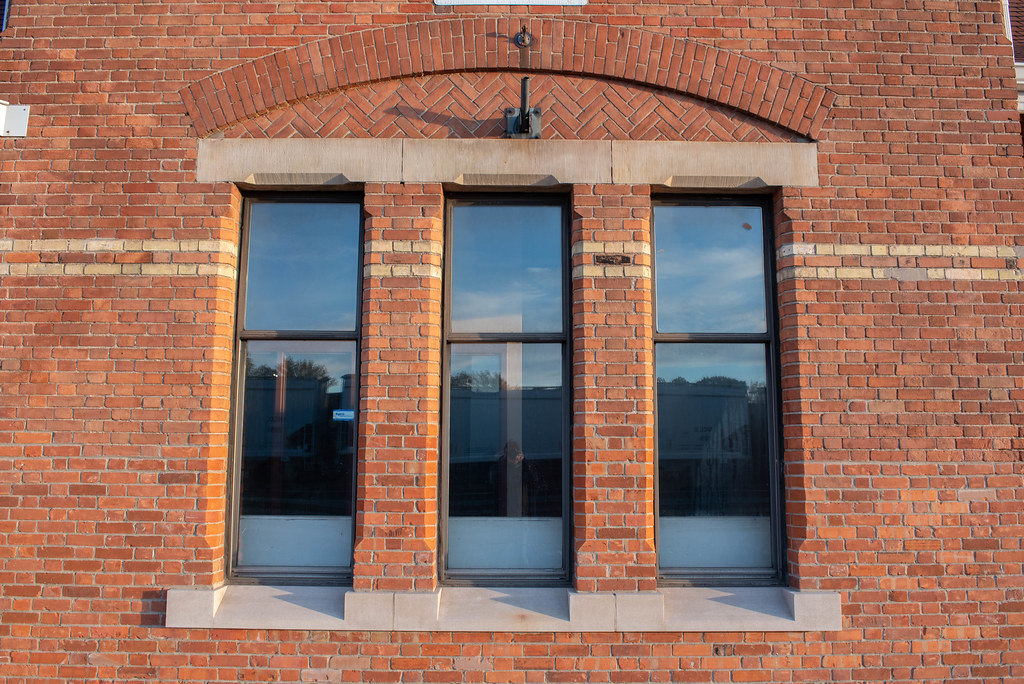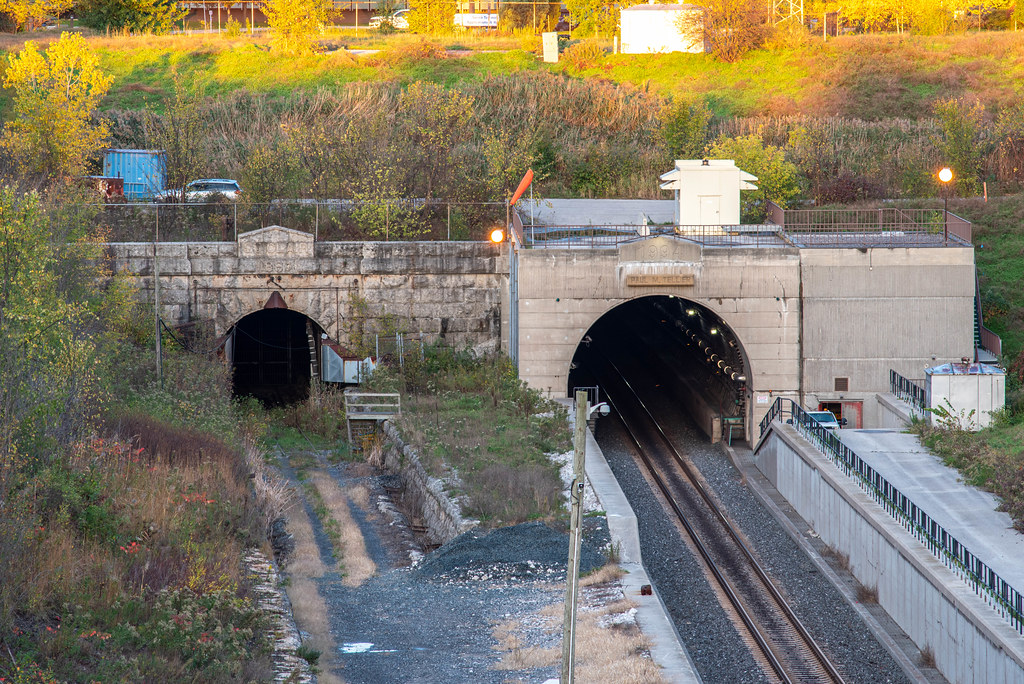Like many still active historic railway stations, the Sarnia VIA station is lonely. The station, located far outside the downtown, is among the industrial wastes of the oil industry. Yet this station stands out, being a surviving Hobson Station and directly linked with Canada’s first underwater railway tunnel as it once bore that name proudly as Sarnia Tunnel.

Graflex Crown Graphic – Fuji Fujinon-W S 1:5.6/150 – Ilford HP5+ @ ASA-200 – Pyrocat-HD (1+1+100) 9:00 @ 20C
Since the earliest days of building railroads through Upper Canada (Ontario), Sarnia began petitioning for a railway charter. The community even paid out of pocket in 1836 to have Captain Richard Vidal go to York (Toronto), no small feat, to speak directly to the Colonial Parliament. The goal of the Captain’s journey was to gain funding to extend a chartered railway to Sarnia. But no railways even put shovels in the ground until two decades later. By the latter half of the 1850s, the two biggest rivals in early railway, Great Western and Grand Trunk, were rushing towards Sarnia. Great Western has started a branch line from the small community of Komoka and the Grand Trunk building west of St. Mary’s. Great Western reached Sarnia first, building their small station at the foot of Cromwell Street and the needed rail ferry docks to send railcars across the river to Port Huron and significant maintenance and staging yard. Grand Trunk established its presence further north at Point Edward. Here Grand Trunk constructed a grand white brick station. The largest station was built outside of Toronto. But with a fair bit of shady real estate dealings to gain control of the land from the Militia. Constructed in the Italianate style, the station featured a long rectangular footprint with a central two-storey section. The second floor holds mainly offices. The first floor featured a pair of waiting rooms for first and second-class passengers: Additionally, lady’s parlour and men’s smoking room and a full-service restaurant. The station also provided rail traffic across the river with box and passenger cars travelling on a separate ferry from the passengers. The station hosted royalty in Prince Edward Albert (future King Edward VII) and those furthest from immigrants hoping to make a better life in Western Canada and the United States. The station burned down in 1871 and was replaced by a similar station made of wood instead of brick but in the same style. When Grand Trunk took over Great Western in 1882, all passenger services for Sarnia moved to the Point Edward station while cargo went to Sarnia.

Nikon D750 – AF-S Nikkor 28-70mm 1:2.8D
Nikon D750 – AF-S Nikkor 28-70mm 1:2.8D
As rail services only increased, the rail ferries became a central sticking point. These were slow, with limited space and a tendency to sink. Using the skills gained with noted railway engineer Joseph Hobson began planning a new way to send trains across a river. In comparison, the railroad bridge had been done, as had a tunnel. But how about a tunnel under a river? Joseph Hobson joined forces with Alfred Beach to plan a new tunnel across and under the St. Clair River. To better access their railyards in Port Huron, a shift in operations was needed to balance their Great Western holdings and their own in Port Edward. Construction of the new railyard, tunnel, and station started in 1890, southwest of Sarnia’s downtown, in a heavily industrialised city section. Building on the tunnel moved slowly, about 2.5 metres per day, using a shield and compressed air. The station followed the designs by Joseph Hobson, with a similar look and felt to the Point Edward station. The long rectangular station followed the Gothic Revival style with tall narrow windows and a high-peak hip roof. The exterior was completed in red brick laid in Flemish bond. Additional details were added with bands of buff bricks and limestone lintels. The long first floor was divided into multiple waiting rooms and an entry concourse with ticket windows. A small second floor contained the station master’s office and telegraph operator. Both the station and the new tunnel opened in 1891. The tunnel is nearly two kilometres long, with about 700 metres underwater. The significant maintenance and staging yard featured a full roundhouse. Grand Trunk operated the waterfront station until 1900. And they were selling the Point Edward holdings and the original Great Western yards to Pere Marquette Railway (a precursor to CSX that continues to operate today in the same space). The problem with the tunnel was that the steam locomotives of the day were not friendly to an enclosed space, and by 1908 tunnel traffic was led by electric locomotives. Around the same time, the station received a new paint job with a two-tone appearance being maintained.

Nikon D750 – AF-S Nikkor 28-70mm 1:2.8D
Nikon D750 – AF-S Nikkor 28-70mm 1:2.8D
When Canadian National took over operations in 1923, they gained an extensive network in Ontario and an equally large network in the United States. Operations at Sarnia continued without significant change through the first half of the twentieth century. The most significant change came from switching to diesel-electric as the primary motive power on the Canadian National lines. The needed infrastructure to support the electrical locomotives in the tunnels was removed, and many steam-related maintenance facilities were removed. However, the roundhouse would only be partly demolished and sold to private interests as a maintenance facility. The station would be renovated with the separate waiting rooms combined into a single space and the second floor closed off. The entire exterior was painted a flat grey colour. Passenger services out of Sarnia ceased in 1971, although not immediately after VIA rail took over in 1981. The station’s waiting area again received a renovation to a clean, simple utilitarian space taking up only half of the station. At the same time, the interior historical elements were stripped. With the influence of local historical societies, VIA restored the original exterior with the grey paint stripped and the original bricks revealed. The start of negotiations for a new North American Free Trade Agreement in 1989 set the president of Canadian National, Paul M. Teller thinking that the old St. Clair Tunnel would need an upgrade. The new train cars and locomotives were getting too big for the tunnel, and a return of rail ferry service had started. The St. Clair Tunnel received its historical designation first in the United States and then in Canada in the 1990s. The station took its historic designation at the Federal level in 1994. Construction of a new tunnel began in 1994. But this time, a specialised Excalibur machine moved parallel to the original tunnel. While the new tunnel would only support a single track, the diameter was far larger to future-proof the tunnel, and it opened in 1995, in time for the ratification of NAFTA. Sarnia lost its passenger service in 2004; the station remained in the ownership of VIA, but when plans and money were made to return limited service to the station, the years had taken their toll. Thanks to local historical groups, VIA began a significant restoration and repair work in 2015 and continued through 2016. Most of the work focused on the masonry and roof work, and when service restarted in 2016, the station was ready. Today the station serves two daily trains, with about half the station remaining active and accessible to the public, although uncrewed.

Nikon D750 – AF-S Nikkor 28-70mm 1:2.8D
Nikon D750 – AI-S Nikkor 200mm 1:4